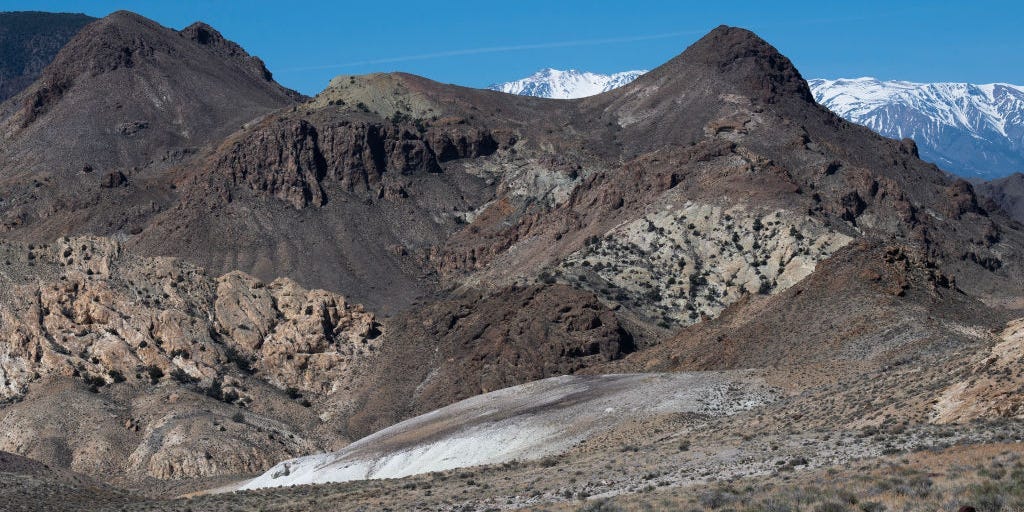- US lithium production is set to spike with new projects advancing in Nevada and California.
- The expansion aims to reduce reliance on China for critical minerals and electric-vehicle batteries.
- Some environmental groups and Native tribes say the mines threaten wildlife and sacred sites.
The US is on the cusp of a lithium boom after years of laying the groundwork for an electric-vehicle supply chain that doesn’t rely on China.
Within the past month, the Biden administration has approved the Rhyolite Ridge lithium-boron mine in Nevada and loaned $2.6 billion to the company developing Thacker Pass, another lithium mine in the state. A project in California’s Salton Sea started construction earlier this year. The three sites, expected to come online between 2026 and 2028, would massively increase the US’s lithium supply. Since the 1960s, only one site, Silver Peak, in Nevada, has operated in the country.
The expansion is aimed at curbing China’s control over the metals used in EV batteries and other renewable-energy technologies that countries need to decarbonize their economies. While most of the world’s lithium is produced in Australia and South America, some two-thirds of it is processed in China, which also dominates EV-battery manufacturing. The US imports about 25% of its lithium supply from Chile and Argentina, but an analysis of federal data by the Atlantic Council found that it relied on China for about 70% of its lithium-ion batteries in 2023.
“If we’re electrifying the transportation industry, you don’t want to rely on any one country,” Bernard Rowe, a managing director of Ioneer, which is developing Rhyolite Ridge, told Business Insider. “There was a recognition that there had to be domestic production.”
The Biden administration is encouraging US mining and manufacturing through a mix of loans, grants, tax breaks, and research and development programs — a lot of which was authorized under the Inflation Reduction Act. The incentives cover activities including extracting critical minerals like lithium; manufacturing solar, wind, and battery parts; buying EVs; and recycling components.
Rowe argued that while the US alone can’t meet the skyrocketing demand for lithium due to rising sales of EVs and battery storage, some of the supply has to be sourced domestically for national security reasons.
Karl Friedhoff, a fellow for Asia studies at the Chicago Council on Global Affairs, agreed. He said there’s no world in which the US and its partners can quickly compete with China on critical minerals; China already has so much capacity that it sets global prices.
“The question then is, can the US and other partner countries create a supply chain that meets their basic requirements,” Friedhoff, who’s part of a project exploring how the US, Japan, Australia, and India can cooperate to shift supply chains away from China. “Can we supply our own batteries? Can we build our own battery technologies? Do we have enough rare-earth elements for defense?”
Based on estimates from Ioneer and other lithium project developers, the US could produce more than enough supply for the 1.4 million EVs sold in the country last year, which accounted for 7% of the auto market.
The Biden administration wants EVs to account for at least 50% of car sales by 2030, and states like California and Texas are quickly deploying more battery storage to help balance stressed power grids. In September, the White House said US lithium production was on track to meet one-fifth of global demand outside of China this decade.
Some environmentalists, Native tribes are alarmed
The lithium projects haven’t been without controversy, however. The Center for Biological Diversity has threatened to sue the Biden administration over its permit for Rhyolite Ridge, arguing that the project could drive an endangered wildflower to extinction. The Western Shoshone Defense Project, which works to protect the Western Shoshone peoples’ native homelands, says the mine threatens local water sources and culturally important sites.
Thacker Pass faced similar opposition, but a federal judge last year dismissed a lawsuit from three Native tribes who argued that the mine’s construction near a sacred site along Nevada’s border with Oregon violated the law, the AP reported.
Rowe said Ioneer redesigned the Rhyolite Ridge mine to limit its footprint in the critical habitat of the endangered wildflower, Tiehm’s buckwheat. He said Ioneer would also monitor the pollinator population and adopt dust-control strategies. The Biden administration, in issuing the permit for the mine, said it would not jeopardize the flower’s survival.
Some companies are working on direct lithium extraction techniques that don’t involve open-pit mining or large evaporation ponds and therefore could require less land and water and produce less toxic chemical waste. Controlled Thermal Resources is developing such a project in the Salton Sea, where lithium-rich brine is already being used to power geothermal plants.
Tapping the US’s newly discovered lithium resources likely hinges on the new extraction techniques, which currently cost more than traditional methods and still haven’t been used commercially. The US Geological Survey this month estimated that there’s enough lithium underneath southwestern Arkansas to meet the projected global demand for car batteries in 2030 nine times over.
Actually extracting that lithium, including from brines left over from oil and gas production in the region, depends on whether the direct extraction techniques are viable, USGS researchers said.
Read the full article here
















